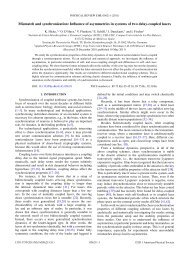DBI Analysis of Open String Bound States on Non-compact D-branes
DBI Analysis of Open String Bound States on Non-compact D-branes
DBI Analysis of Open String Bound States on Non-compact D-branes
You also want an ePaper? Increase the reach of your titles
YUMPU automatically turns print PDFs into web optimized ePapers that Google loves.
CHAPTER 8. COMPUTATIONS 998.4 Regularized LagrangianBefore varying the acti<strong>on</strong> c<strong>on</strong>taining the perturbed field strength, and ultimatly computingthe equati<strong>on</strong>s <str<strong>on</strong>g>of</str<strong>on</strong>g> moti<strong>on</strong> for the fluctuati<strong>on</strong>, we note that we will again need toinvoke the Lagrange multiplier. As such, we first computeL <str<strong>on</strong>g>DBI</str<strong>on</strong>g> −λf√k (α 2 − 1) . (8.17)To this end, the first thing to do is to expand the Lagrangian density,√L <str<strong>on</strong>g>DBI</str<strong>on</strong>g> = A −α 2 det(g αβ + 2π ˜F)αβ{ 1= Ak − 4π2 α 2α 2 − 1 (∂ tα τ ) 2 − 4π 2 (∂ t α ρ ) 2 + 4π2 α 2k (α 2 − 1) F ρτ2}+ 8π2 α 2k (α 2 − 1) F ρτf + 4π2 α 2k (α 2 − 1) f2= A√(α 2 − 1) + 4π 2 α 2 F 2 ρτk (α 2 − 1){4π 2 α 2 k1 −(α 2 − 1) + 4π 2 α 2 Fρτ2 (∂ t α τ ) 24π 2 ( α 2 − 1 ) k−(α 2 − 1) + 4π 2 α 2 Fρτ2 (∂ t α ρ ) 2 8π 2 α 2+(α 2 − 1) + 4π 2 α 2 Fρτ2 F ρτ f4π 2 α 2+(α 2 − 1) + 4π 2 α 2 Fρτ2 f}. 2 (8.18)For the expansi<strong>on</strong>, we find up to sec<strong>on</strong>d order:√{(α 2 − 1) + 4π 2 α 2 Fρτ2 2π 2 α 2 kL <str<strong>on</strong>g>DBI</str<strong>on</strong>g> ≈ Ak (α 2 1 −− 1) (α 2 − 1) + 4π 2 α 2 Fρτ2 (∂ t α τ ) 22π 2 ( α 2 − 1 ) k−(α 2 − 1) + 4π 2 α 2 Fρτ2 (∂ t α ρ ) 2 4π 2 α 2+(α 2 − 1) + 4π 2 α 2 Fρτ2 F ρτ f[]2π 2 α 28π 4 α 4 Fρτ2 +(α 2 − 1) + 4π 2 α 2 Fρτ2 − ( )(α 2 − 1) + 4π 2 α 2 Fρτ2 2f}. 2 (8.19)Looking back at Eq. 8.17, we see we <strong>on</strong>ly need to c<strong>on</strong>sider the term ∼ F ρτ in thisexpansi<strong>on</strong> when computing the effect <str<strong>on</strong>g>of</str<strong>on</strong>g> the Lagrange multiplier. We will want bothterms to annul each other, as otherwise the equati<strong>on</strong>s <str<strong>on</strong>g>of</str<strong>on</strong>g> moti<strong>on</strong> will c<strong>on</strong>tain c<strong>on</strong>stantterms (i.e. without f) we do not want. Anticipating this result, in order not to clutterpages with unreadable derivati<strong>on</strong>s, we work out the ∼ F ρτ term when filling in the
















